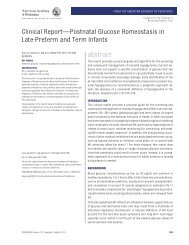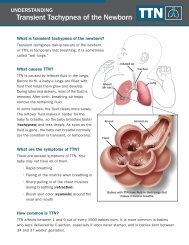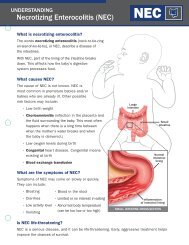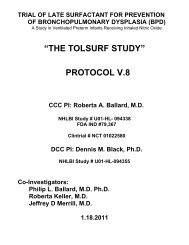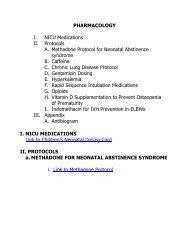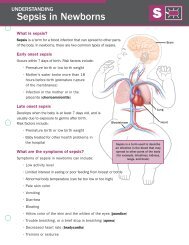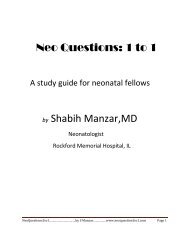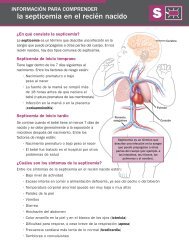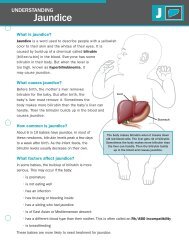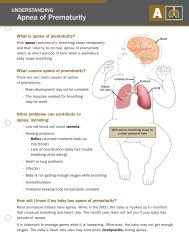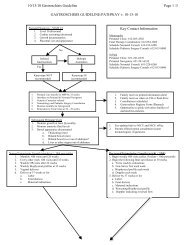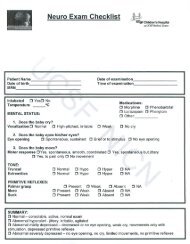Neonatal Presentations of CHARGE Syndrome and VATER
Neonatal Presentations of CHARGE Syndrome and VATER
Neonatal Presentations of CHARGE Syndrome and VATER
- No tags were found...
You also want an ePaper? Increase the reach of your titles
YUMPU automatically turns print PDFs into web optimized ePapers that Google loves.
<strong>Neonatal</strong> <strong>Presentations</strong> <strong>of</strong> <strong>CHARGE</strong> <strong>Syndrome</strong> <strong>and</strong> <strong>VATER</strong>/VACTERLAssociationJulie Kaplan <strong>and</strong> Louanne HudginsNeoReviews 2008;9;e299-e304DOI: 10.1542/neo.9-7-e299The online version <strong>of</strong> this article, along with updated information <strong>and</strong> services, islocated on the World Wide Web at:http://neoreviews.aappublications.org/cgi/content/full/neoreviews;9/7/e299NeoReviews is the <strong>of</strong>ficial journal <strong>of</strong> the American Academy <strong>of</strong> Pediatrics. A monthly publication,it has been published continuously since 2000. NeoReviews is owned, published, <strong>and</strong> trademarkedby the American Academy <strong>of</strong> Pediatrics, 141 Northwest Point Boulevard, Elk Grove Village,Illinois, 60007. Copyright © 2008 by the American Academy <strong>of</strong> Pediatrics. All rights reserved.Online ISSN: 1526-9906.Downloaded from http://neoreviews.aappublications.org by J Michael Coleman on August 12, 2010
Article genetics<strong>Neonatal</strong> <strong>Presentations</strong> <strong>of</strong><strong>CHARGE</strong> <strong>Syndrome</strong> <strong>and</strong> <strong>VATER</strong>/VACTERL AssociationJulie Kaplan, MD,*Louanne Hudgins, MD*Author DisclosureDrs Kaplan <strong>and</strong>Hudgins havedisclosed no financialrelationships relevantto this article. Thiscommentary does notcontain a discussion<strong>of</strong> an unapproved/investigative use <strong>of</strong> acommercial product/device.Objectives After completing this article, readers should be able to:1. Describe the difference between a syndrome <strong>and</strong> an association.2. Recognize the phenotype <strong>of</strong> <strong>CHARGE</strong> syndrome as it presents in the newborn period.3. Recognize the phenotype <strong>of</strong> VACTERL association as it presents in the newborn period.4. Construct a differential diagnosis based on some <strong>of</strong> the common findings in thesedisorders.5. Initiate a plan for diagnostic evaluation <strong>and</strong> management for these two disorders.AbstractNeonatologists <strong>of</strong>ten care for newborns who have multiple congenital anomalies. Thespecific diagnosis has implications for the infant’s clinical management. In this article,we examine the neonatal presentations <strong>of</strong> <strong>CHARGE</strong> syndrome <strong>and</strong> <strong>VATER</strong>/VACTERL association. Once the features <strong>of</strong> these two entities are recognizedclinically, the appropriate diagnostic evaluations can be initiated.IntroductionIn evaluating a newborn who has multiple congenital anomalies, the specific diagnosis hasimplications for management <strong>and</strong> recurrence risk. An association originally was defined bythe International Group in 1982 as a “nonr<strong>and</strong>om occurrence in two or more individuals<strong>of</strong> multiple congenital anomalies not known to be a polytypic defect, sequence orsyndrome.” In general, associations do not have a known genetic cause, are not associatedwith developmental disabilities, <strong>and</strong> have a low recurrence risk for parents <strong>and</strong> the affectedindividual. A syndrome, on the other h<strong>and</strong>, generally refers to a pattern <strong>of</strong> congenitalanomalies that can be explained by a common developmental or genetic cause, <strong>of</strong>ten isassociated with developmental disabilities, <strong>and</strong> can have significant recurrence risk for theparents or the affected individual.The field <strong>of</strong> molecular genetics has seen remarkable advances in the past decade, <strong>and</strong> themolecular causes for various genetic conditions recently have been elucidated. <strong>CHARGE</strong>syndrome is an example <strong>of</strong> a genetic disorder that was referred to previously as anassociation until a molecular cause was discovered. <strong>VATER</strong>/VACTERL still is referred toas an association; the acronym describes anomalies that occur together more <strong>of</strong>ten than bychance alone, but there is currently no known pathogenetic cause.<strong>CHARGE</strong> <strong>Syndrome</strong>In 1979, Hall described 17 children who had multiple congenital anomalies, all <strong>of</strong> whomhad choanal atresia. Also in 1979, Hittner <strong>and</strong> associates described 10 children who hadcoloboma, congenital heart disease, <strong>and</strong> hearing loss. The acronym <strong>CHARGE</strong> initially wascoined by Pagon <strong>and</strong> colleagues in 1981 <strong>and</strong> was defined as including Coloboma, Heartdefect, Atresia choanae, Retarded growth <strong>and</strong> development, Genital hypoplasia, <strong>and</strong> Earanomalies/deafness. Because a common pathogenetic basis was discovered in 2004, theassociation now is referred to as <strong>CHARGE</strong> syndrome. <strong>CHARGE</strong> syndrome has a prevalence<strong>of</strong> 1 per 10,000 to 1 per 15,000, <strong>and</strong> although it is an autosomal dominant disorder,most cases represent simplex cases (the first case discovered in a family).*Division <strong>of</strong> Medical Genetics, Stanford University, Stanford, Calif.NeoReviews Vol.9 No.7 July 2008 e299Downloaded from http://neoreviews.aappublications.org by J Michael Coleman on August 12, 2010
genetics<strong>CHARGE</strong> <strong>and</strong> <strong>VATER</strong>/VACTERLClinical FindingsColobomas are present in 80% to 90% <strong>of</strong> patients whohave <strong>CHARGE</strong> syndrome, <strong>and</strong> retinal colobomas aremore common than iris colobomas (Fig. 1). Retinalinvolvement can affect the optic nerve or macula, leadingto impaired visual acuity. Severe chorioretinal colobomascan be associated with microphthalmia. Newborns inwhom <strong>CHARGE</strong> syndrome is suspected should receivean ophthalmologic evaluation for retinal colobomas <strong>and</strong>be monitored by ophthalmology with an eye examinationevery 6 months.Heart defects are <strong>of</strong>ten complex <strong>and</strong> found in 75% to85% <strong>of</strong> those who have <strong>CHARGE</strong> syndrome. Althoughcardiac defects can vary substantially, conotruncal anomalies(tetralogy <strong>of</strong> Fallot, double-outlet right ventricle,truncus arteriosus, <strong>and</strong> perimembranous ventricular septaldefect) <strong>and</strong> aortic arch anomalies (interrupted aorticarch, vascular ring, <strong>and</strong> aberrant subclavian artery) comprise38% to 40% <strong>of</strong> the defects seen in <strong>CHARGE</strong> syndrome.Other common defects include atrioventricularcanal defects, atrial septal defects, ventricular septal defects,<strong>and</strong> patent ductus arteriosus.Choanal atresia is a blockage in the passages betweenthe nasal cavity <strong>and</strong> the nasopharynx. Affected individualsmay have a complete blockage (choanal atresia) or apartial blockage (choanal stenosis), <strong>and</strong> the blockage maybe unilateral or bilateral. Whereas bilateral choanal atresiacauses significant respiratory distress in the newborn,unilateral choanal atresia or choanal stenosis may not bedetected in the newborn period; the older child who haschoanal stenosis or unilateral choanal atresia may presentwith persistent rhinorrhea or infections. Choanal atresiaor stenosis is present in 50% to 60% <strong>of</strong> patients who have<strong>CHARGE</strong> syndrome <strong>and</strong> should focus the clinician’sattention on involvement <strong>of</strong> other organ systems, such asthe eye <strong>and</strong> heart. Individuals who have bilateral posteriorchoanal atresia <strong>of</strong>ten have a prenatal history <strong>of</strong> polyhydramnios,believed to be due to an insufficient swallowingmechanism. The inability to pass a nasogastrictube should alert the clinician to the possibility <strong>of</strong> choanalatresia, but computed tomography (CT) scan <strong>of</strong> thenasopharynx <strong>and</strong> nasal cavity is necessary to evaluate thequality <strong>of</strong> the blockage. Bilateral choanal atresia is amedical emergency that should be corrected surgically assoon as possible. Chronic otitis media <strong>and</strong> deafness arepotential complications <strong>of</strong> choanal atresia.Infants affected with <strong>CHARGE</strong> syndrome typicallyhave normal growth parameters at birth, but their lineargrowth tends to decline by late infancy. Some childrenhave been found to have growth hormone deficiency,but growth deceleration frequently is due to cardiac,Figure 1. Retinal coloboma.respiratory, or feeding problems. Early intervention forfeeding difficulties is important.Most children who have <strong>CHARGE</strong> syndrome showmarked delays in motor development. Such delays can bedue to prolonged hospitalizations, truncal hypotoniawith ligamentous laxity, decreased visual acuity, or vestibulardisturbances. Language development <strong>of</strong>ten is delayedas well due to hearing loss. Other individuals mayhave central nervous system abnormalities that can includearrhinencephaly; holoprosencephaly; hypoplasia <strong>of</strong>the cerebellum, inferior cerebellar vermis, <strong>and</strong> brainstem;cerebellar heterotopias; <strong>and</strong> absence <strong>of</strong> the septum pellucidum.Due to the variable nature <strong>of</strong> the developmentaldelay, the extent <strong>of</strong> the delay should not be used topredict cognitive function. Cognitive function may rangefrom learning disabilities to pr<strong>of</strong>ound mental retardation.Genital hypoplasia is present in about 50% to 60% <strong>of</strong>males who have <strong>CHARGE</strong> syndrome <strong>and</strong> can manifest asmicrophallus, hypospadias, cryptorchidism, chordee, <strong>and</strong>bifid scrotum. Female genital hypoplasia may be moredifficult to recognize externally, but hypoplastic labia <strong>and</strong>clitoris <strong>and</strong> atresia <strong>of</strong> the uterus, cervix, <strong>and</strong> vagina havebeen reported. Renal anomalies have been reported in25% to 40% <strong>of</strong> individuals <strong>and</strong> include unilateral renalagenesis, hydronephrosis, renal hypoplasia, duplex kidneys,<strong>and</strong> vesicoureteral reflux. Hypogonadotropic hypogonadismcan occur in males <strong>and</strong> females <strong>and</strong> is associatedwith delays in puberty <strong>and</strong> low concentrations <strong>of</strong>luteinizing hormone <strong>and</strong> follicle-stimulating hormone.Ear anomalies occur in approximately 90% <strong>of</strong> children<strong>and</strong> can involve the outer, middle, or inner ear. Thetypical “<strong>CHARGE</strong> ear” is protuberant, short, <strong>and</strong> wide,with a hypoplastic lobule, prominent antihelix, <strong>and</strong> tri-e300 NeoReviews Vol.9 No.7 July 2008Downloaded from http://neoreviews.aappublications.org by J Michael Coleman on August 12, 2010
genetics<strong>CHARGE</strong> <strong>and</strong> <strong>VATER</strong>/VACTERLangular concha (Fig. 2). Middle ear anomalies includeossicular malformations, an abnormal or absent ovalwindow, <strong>and</strong> absent stapedius muscle. Among the innerear anomalies are aplastic or hypoplastic semicircularcanals, <strong>and</strong> the Mondini defect (decreased number <strong>of</strong>turns to the cochlea) is present in up to 95% <strong>of</strong> affectedindividuals <strong>and</strong> can be detected by CT scan <strong>of</strong> the temporalbones. Temporal bone abnormalities also may bepresent. The combination <strong>of</strong> ossicular malformations <strong>and</strong>inner ear defects frequently results in a mixed (conductive<strong>and</strong> sensorineural) hearing loss that can range frommild to pr<strong>of</strong>ound.Although not described in the original acronym, cranialnerve (CN) anomalies also are common <strong>and</strong> now areincluded among the major diagnostic criteria (Table).Such anomalies usually are asymmetric <strong>and</strong> can involveCN I, resulting in hyposmia or anosmia (an absentor hypoplastic olfactory bulb is highly indicative <strong>of</strong><strong>CHARGE</strong>); CN V, resulting in the incoordination <strong>of</strong>sucking, chewing, <strong>and</strong> swallowing; CN VII, resulting infacial paralysis that is usually unilateral (Fig. 3); CN VIII,resulting in sensorineural hearing loss; <strong>and</strong> CN IX/X/XI, resulting in dysfunctional swallowing, gastroesophagealreflux, <strong>and</strong> velopharyngeal aspiration.A clinical diagnosis <strong>of</strong> <strong>CHARGE</strong> syndrome can bemade based on the major <strong>and</strong> minor diagnostic criteria(Table) defined by Blake <strong>and</strong> associates in 1998. Thepresence <strong>of</strong> all four major criteria (choanal atresia,coloboma, characteristic ears, <strong>and</strong> cranial nerve anomalies)or three major <strong>and</strong> three minor characteristics indicatesa diagnosis <strong>of</strong> <strong>CHARGE</strong> syndrome. The diagnosisshould be considered strongly in any neonate who exhibitsone <strong>of</strong> the major diagnostic criteria, <strong>and</strong> evaluation forabnormalities in other organ systems involved in<strong>CHARGE</strong> should be initiated.Figure 2. Hypoplastic lobule, prominent antihelix, <strong>and</strong> trangularconcha characteristic <strong>of</strong> the typical “<strong>CHARGE</strong> ear.”Genetic TestingIn 2004, Vissers <strong>and</strong> colleagues identified a molecularcause for <strong>CHARGE</strong> syndrome. The responsible gene isCHD7 (chromodomain helicase DNA-binding protein7); the encoded protein regulates gene expression byaltering chromatin structure <strong>and</strong> plays a critical role inembryogenesis. Clinical testing is currently available, <strong>and</strong>the mutation detection frequency is approximately 60%to 65%.Despite the availability <strong>of</strong> mutation analysis,<strong>CHARGE</strong> syndrome remains a clinical diagnosis. In theneonatal period, the presence <strong>of</strong> iris or retinal coloboma,choanal atresia, characteristic ears, hearing loss, facialnerve palsy, or congenital heart defects should alert thephysician to the possible diagnosis. The evaluations initiatedin the neonatal intensive care unit should includean ophthalmology examination, echocardiography, earnose-throatevaluation, renal ultrasonography, <strong>and</strong> hearingscreen. The most sensitive diagnostic study, whichhas implications for management, is a CT scan <strong>of</strong> thetemporal bones. Approximately 95% <strong>of</strong> affected patientshave abnormalities <strong>of</strong> the inner <strong>and</strong> middle ear, includingthe Mondini defect, aplasia or hypoplasia <strong>of</strong> the semicircularcanals, <strong>and</strong> ossicular malformations. A highresolutionkaryotype should be performed to rule out achromosomal abnormality as the cause <strong>of</strong> multiple malformations.CHD7 analysis may be helpful in cases wherethe diagnosis is not clear, especially if the family is interestedin prenatal diagnosis for future pregnancies. Insimplex cases, the recurrence risk for the parents is low,but prenatal testing can be <strong>of</strong>fered to the family if there isa known mutation to rule out the unlikely event <strong>of</strong>germline mosaicism. The individual who has <strong>CHARGE</strong>syndrome has a 50% risk <strong>of</strong> having an affected child witheach pregnancy.<strong>VATER</strong>/VACTERL AssociationIn contrast to <strong>CHARGE</strong> syndrome, <strong>VATER</strong> (orVACTERL) association does not have a known molecularcause. <strong>VATER</strong> association initially was described byQuan <strong>and</strong> Smith in 1973, <strong>and</strong> the acronym describes thecomponents: Vertebral defects, Anal atresia, Tracheo-Esophageal fistula with esophageal atresia, <strong>and</strong> Radial<strong>and</strong> Renal dysplasia. Kaufman (1973) <strong>and</strong> Nora <strong>and</strong>Nora (1975) subsequently added “C” for cardiac defects<strong>and</strong> “L” for limb defects to broaden the acronym toVACTERL.NeoReviews Vol.9 No.7 July 2008 e301Downloaded from http://neoreviews.aappublications.org by J Michael Coleman on August 12, 2010
genetics<strong>CHARGE</strong> <strong>and</strong> <strong>VATER</strong>/VACTERLTable. Diagnostic Criteria <strong>of</strong> <strong>CHARGE</strong> <strong>Syndrome</strong>Feature Manifestations FrequencyMajor Diagnostic Criteria (4 Cs)ColobomaChoanal Atresia/stenosisCranial Nerve DysfunctionCharacteristic Ear AnomaliesMinor Diagnostic CriteriaCardiovascular MalformationsColoboma <strong>of</strong> the retina, iris, choroid, <strong>and</strong> disc;microphthalmiaUnilateral or bilateral, membranous or bony, stenosis oratresiaOlfactory tract anomalies, unilateral or bilateral facial palsy,sensorineural hearing loss, velopharyngeal incoordinationOuter: Short, wide, hypoplastic lobule, prominent antihelix,triangular conchaMiddle: Ossicular malformationsInner: Aplastic or hypoplastic semicircular canals, MondinidefectTemporal bone abnormalities80% to 90%50% to 60%75% to 95%Most commonly conotruncal defects, atrioventricular canal 75% to 85%defects, <strong>and</strong> aortic arch abnormalitiesGenital HypoplasiaMales: Microphallus, cryptorchidism50% to 60%Females: Hypoplastic labiaBoth: Hypogonadotropic hypogonadismDevelopmental Delay Delayed motor milestones, delayed language, hypotonia 100%Growth DeficiencyShort stature (usually postnatal), occasional growth hormone 70% to 80%deficiencyOr<strong>of</strong>acial Cleft Cleft lippalate 15% to 20%Tracheoesophageal Fistula All types 15% to 20%Distinctive Facial FeaturesSquare face with broad prominent forehead, prominent nasalbridge <strong>and</strong> columella, flat midface70% to 80%Occasional AbnormalitiesRenal AnomaliesSpinal AnomaliesH<strong>and</strong> AnomaliesNeck/Shoulder AnomaliesGastrointestinalUnilateral renal agenesis, horseshoe kidney, hydronephrosis,renal hypoplasia, duplex kidney, vesicoureteral refluxScoliosis, kyphosis, osteoporosis, hemivertebraePolydactyly, altered palmar flexion creases, atypical splith<strong>and</strong>/split foot deformity, clinodactyly, camptodactyly,cutaneous syndactylyShort/webbed neck, Sprengel deformityOmphalocele, umbilical hernia90%Clinical FindingsVertebral defects that have been described in VACTERLassociation include hemivertebrae, congenital scoliosis,hypersegmentation defects, <strong>and</strong> sacral dysgenesis; thoracolumbarhemivertebrae have been reported most frequently.Anal atresia or stenosis requires prompt surgicalconsultation <strong>and</strong> intervention. A wide range <strong>of</strong> cardiacanomalies have been described in the VACTERL association,although septal defects appear to be most common.Tracheoesophageal fistula or esophageal atresiaoccurs in approximately 1 in 3,500 births <strong>and</strong> is associatedwith other anomalies in about 50% <strong>of</strong> cases. Renalanomalies include renal agenesis, ureteropelvic junctionobstruction, <strong>and</strong> severe reflux. Limb defects tend toinvolve the upper limbs more <strong>of</strong>ten than the lower limbs;with upper limb involvement, the radial bones are affectedmore frequently than the ulnar bones. Radialaplasia, deviation <strong>of</strong> the h<strong>and</strong>, absence <strong>of</strong> the thumb,hypoplastic <strong>and</strong> rudimentary thumb, <strong>and</strong> preaxial polydactylyhave been described.Individuals who have VACTERL association usuallydo not have dysmorphic facial features, abnormalities <strong>of</strong>growth, or mental deficiency. Therefore, VACTERL is adiagnosis <strong>of</strong> exclusion that should not be made until atleast 1 year <strong>of</strong> age, when growth <strong>and</strong> development can beconfirmed to be normal.The differential diagnosis in the newborn periodincludes <strong>CHARGE</strong> syndrome, 22q11 deletion syndrome,<strong>and</strong> Townes-Brocks syndrome. Infants who have<strong>CHARGE</strong> syndrome can have cardiac defects, tracheoesophagealfistula, vertebral anomalies, <strong>and</strong> renal anomalies.If the diagnosis <strong>of</strong> <strong>CHARGE</strong> syndrome is consid-e302 NeoReviews Vol.9 No.7 July 2008Downloaded from http://neoreviews.aappublications.org by J Michael Coleman on August 12, 2010
genetics<strong>CHARGE</strong> <strong>and</strong> <strong>VATER</strong>/VACTERLis usually sporadic. VACTERL-H is associated with apoorer prognosis in terms <strong>of</strong> survival <strong>and</strong> mental h<strong>and</strong>icap.Overlap in the features associated withVACTERL-H <strong>and</strong> Fanconi anemia has been reported inseveral cases. Fanconi anemia is an autosomal recessivedisorder <strong>of</strong> DNA repair that leads to bone marrow failurein childhood <strong>and</strong> increased risk <strong>of</strong> malignancy; diagnosiscan be made using chromosomal breakage studies. In2005, Faivre <strong>and</strong> associates recommended chromosomalbreakage studies in cases <strong>of</strong> VACTERL-H <strong>and</strong> cases <strong>of</strong>VACTERL in which the infant has dysmorphic features,skin pigmentation abnormalities, growth retardation, ormicrocephaly.Figure 3. Unilateral facial paralysis caused by an anomaly <strong>of</strong>cranial nerve VII.ered, a CT scan <strong>of</strong> the temporal bones should beobtained to look for the suggestive middle <strong>and</strong> inner eardefects. The phenotype <strong>of</strong> 22q11 deletion syndrome isextremely variable; cardiac <strong>and</strong> renal anomalies are common,but anomalies in almost every organ system havebeen reported. Newborns who have a 22q11 deletionfrequently exhibit a distinctive facial appearance (laterallybuilt-up nasal bridge, small mouth, <strong>and</strong> short palpebralfissures), long fingers <strong>and</strong> toes, <strong>and</strong> possibly hypocalcemia.A fluorescence in situ hybridization study for22q11.2 deletion can be ordered to exclude this diagnosis.Townes–Brocks syndrome is characterized by thetriad <strong>of</strong> imperforate anus, dysplastic ears (with or withoutpits or tags <strong>and</strong> hearing loss), <strong>and</strong> thumb anomalies(triphalangeal thumbs, preaxial polydactyly, or hypoplasticthumbs). Affected infants also may have cardiac <strong>and</strong>renal anomalies. This syndrome should be considereddue to the considerable overlap in phenotype. Clinicallyavailable genetic testing for Townes-Brocks syndromehas a detection rate <strong>of</strong> 70% to 75%.Multiple case reports have linked hydrocephalus withVACTERL association (VACTERL-H). VACTERL-Hmay represent a distinct syndrome because both autosomalrecessive <strong>and</strong> X-linked patterns <strong>of</strong> inheritancehave been described. In contrast, VACTERL associationGenetic TestingIf VACTERL association is considered, evaluations inthe neonatal period should include echocardiography,renal ultrasonography, radiographs <strong>of</strong> the spine, radiographs<strong>of</strong> the extremities if abnormalities are noted onexamination, <strong>and</strong> an ophthalmologic evaluation. Inaddition, high-resolution chromosome analysis <strong>and</strong> agenetics consultation should be obtained to excludeother genetic causes. The recurrence risk for parents <strong>and</strong>for the individual is low, <strong>and</strong> the cause is unknown,although VACTERL is related to maternal diabetes inthe minority <strong>of</strong> cases.SummaryAlthough <strong>CHARGE</strong> syndrome <strong>and</strong> VACTERL associationhave several features in common, the distinctionbetween these two entities affects management, prognosis,<strong>and</strong> recurrence risk. In addition, a broad differentialdiagnosis needs to be considered in any patient whohas features <strong>of</strong> VACTERL association because this is adiagnosis <strong>of</strong> exclusion. A genetics evaluation should beconsidered for any newborn who has multiple congenitalanomalies.Suggested ReadingBlake KD, Devenport SL, Hall BD, et al. <strong>CHARGE</strong> association: anupdate <strong>and</strong> review for the primary pediatrician. Clin Pediatr.1998;37:159–173Blake KD, Hartshorne TS, Law<strong>and</strong> C, Dailor AN, Thelin JW.Cranial nerve manifestations in <strong>CHARGE</strong> syndrome. Am J MedGenet. 2008;146A:585–592Blake KD, Prasad C. <strong>CHARGE</strong> syndrome. Orphanet J Rare Dis.2006;1:34Corsello G, Maresi E, Corrao AM, et al. <strong>VATER</strong>/VACTERLassociation: clinical variability <strong>and</strong> exp<strong>and</strong>ing phenotype includinglaryngeal stenosis. Am J Med Genet. 1992;44:813–815NeoReviews Vol.9 No.7 July 2008 e303Downloaded from http://neoreviews.aappublications.org by J Michael Coleman on August 12, 2010
genetics<strong>CHARGE</strong> <strong>and</strong> <strong>VATER</strong>/VACTERLCox PM, Gibsin RA, Morgan N, Brueton LA. VACTERL withhydrocephalus in twins due to Fanconi anemia (FA): mutationin the FAC gene. Am J Med Genet. 1997;68:86–90Faivre L, Portnoi MF, Pals G, et al. Should chromosome breakagestudies be performed in parents with VACTERL association?Am J Med Genet. 2005;137:55–58Hall BD. Choanal atresia <strong>and</strong> associated multiple anomalies. J Pediatr.1979;95:395–398Hittner HM, Hirsch NJ, Kreh GM, Rudolph AJ. Colobomatousmicrophthalmia, heart disease, hearing loss, <strong>and</strong> mentalretardation—a syndrome. J Pediatr. 1979;16:122–128Jongmans MC, Admiraal RJ, van der Donk KP, et al. <strong>CHARGE</strong>syndrome: the phenotypic spectrum <strong>of</strong> mutation in the CHD7gene. J Med Genet. 2006;43:306–314Kallen K, Mastroiacovo P, Castilla EE, Robert E, Kallen B. <strong>VATER</strong>non-r<strong>and</strong>om association <strong>of</strong> congenital malformations: studybased in data from four malformation registers. Am J MedGenet. 2001;101:26–32Kaufman RL. Birth defects <strong>and</strong> oral contraceptives. Lancet. 1973;1:1396Lalani SR, Hefner M, Belmont JW, Davenport SLH. <strong>CHARGE</strong>syndrome. GeneReviews at Genetests: Medical Genetics InformationResource. 2007. Available at: www.genetests.orgNora AH, Nora JJ. A syndrome <strong>of</strong> multiple congenital anomaliesassociated with teratogenic exposure. Arch Environ Health.1975;30:17–21Quan L, Smith DW. The <strong>VATER</strong> association. J Pediatr. 1973;82:104–107Raqbi F, Bihan CL, Morisseau-Dur<strong>and</strong> MP, Dureau P, Lyonnet S,Abadie V. Early prognostic factors for intellectual outcome in<strong>CHARGE</strong> syndrome. Dev Med Child Neurol. 2003;45:483–488Russell-Eggitt IM, Blake KD, Taylor DSI, Wyse RKH. The eye inthe <strong>CHARGE</strong> association. Br J Ophthalmol. 1990;74:421–426Shaw-Smith C. Oesophageal atresia, tracheo-oesophageal fistula,<strong>and</strong> the VACTERL association: review <strong>of</strong> genetics <strong>and</strong> epidemiology.J Med Genet. 2006;43:545–554Temtamy SA, Miller JD. Extending the scope <strong>of</strong> the <strong>VATER</strong>association: definition <strong>of</strong> the <strong>VATER</strong> syndrome. J Pediatr.1974;85:345–349Vissers L, Ravenswaaij C, Admiraal R, et al. Mutations in a newmember <strong>of</strong> the chromodomain gene family cause <strong>CHARGE</strong>syndrome. Nature Genet. 2004;36:955–957NeoReviews Quiz7. A syndrome is a pattern <strong>of</strong> congenital anomalies that can be explained by a genetic abnormality, <strong>of</strong>ten isassociated with developmental disability, <strong>and</strong> can have a significant recurrence risk for the parents or theaffected individual. The clinical manifestations <strong>of</strong> a syndrome <strong>of</strong>ten are classified as major <strong>and</strong> minordiagnostic criteria. Of the following, the major diagnostic criterion with the highest frequency <strong>of</strong>occurrence for <strong>CHARGE</strong> syndrome is:A. Cardiovascular malformation.B. Choanal atresia.C. Cranial nerve dysfunction.D. Genital hypoplasia.E. Intrauterine growth restriction.8. An association is a pattern <strong>of</strong> congenital anomalies that does not have a known genetic cause, rarely leadsto developmental disability, <strong>and</strong> has a low recurrence risk for the parents or the affected individual.VACTERL association is a typical example <strong>of</strong> an association <strong>of</strong> congenital anomalies. Of the following, thecongenital anomaly most characteristic <strong>of</strong> VACTERL association is:A. Facial dysmorphism.B. Mondini inner ear defect.C. Tetralogy <strong>of</strong> Fallot.D. Thoracolumbar hemivertebrae.E. Triphalangeal thumbs.e304 NeoReviews Vol.9 No.7 July 2008Downloaded from http://neoreviews.aappublications.org by J Michael Coleman on August 12, 2010
<strong>Neonatal</strong> <strong>Presentations</strong> <strong>of</strong> <strong>CHARGE</strong> <strong>Syndrome</strong> <strong>and</strong> <strong>VATER</strong>/VACTERLAssociationJulie Kaplan <strong>and</strong> Louanne HudginsNeoReviews 2008;9;e299-e304DOI: 10.1542/neo.9-7-e299Updated Information& ServicesPermissions & LicensingReprintsincluding high-resolution figures, can be found at:http://neoreviews.aappublications.org/cgi/content/full/neoreviews;9/7/e299Information about reproducing this article in parts (figures,tables) or in its entirety can be found online at:http://neoreviews.aappublications.org/misc/Permissions.shtmlInformation about ordering reprints can be found online:http://neoreviews.aappublications.org/misc/reprints.shtmlDownloaded from http://neoreviews.aappublications.org by J Michael Coleman on August 12, 2010



